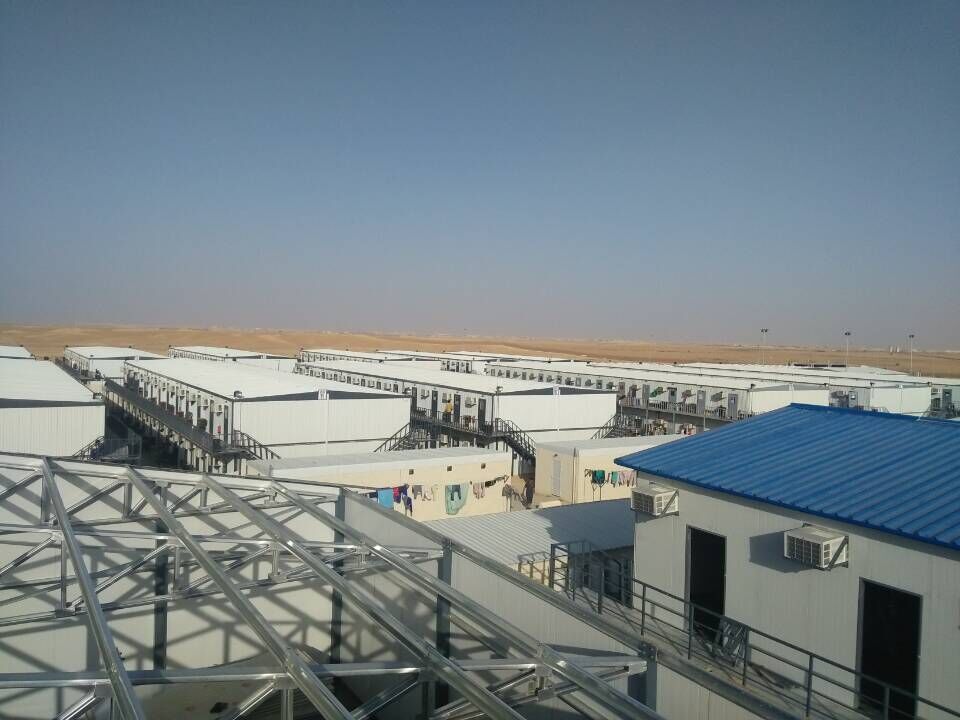Tel: 0086-532-88966982
0086-532-88965892
Website: www.lidajituan.com
E-mail: sales@lidajituan.com
Head office: 5th Floor, Building A, Dalen Center, 180 Haier Road, Qingdao, 266000, China
Oil & Gas Modular House Designs Explosion-Proof Camp House Systems Lida Group
Classification:Industry News
Release time:2025-07-30 12:00
Oil & Gas Modular House Designs Explosion-Proof Camp House Systems Lida Group
The ominous flare stacks of offshore platforms illuminate a silent revolution in hazardous environment engineering. Where conventional site accommodations once stood as vulnerable outposts amid volatile hydrocarbons, Lida Group's engineered modular house solutions now serve as fortified sanctuaries – surviving well control incidents that level lesser structures. This transformation represents the pinnacle of industrial constructions for oil & gas operations, where human safety converges with operational resilience through intrinsically safe design principles.
Combustion Engineering Imperatives
Hydrocarbon processing environments present unique challenges:
- Flammable Atmospheres: Methane concentrations requiring ignition prevention
- Toxic Exposure: Hydrogen sulfide infiltration threatening occupant safety
- Corrosive Degradation: Salt spray compromising structural integrity
- Seismic Vulnerability: Ground movement disrupting critical systems
- Thermal Extremes: Desert heat compromising electronic systems
Standard camp house solutions fail these critical tests. Lida Group's explosion-proof prefabricated house systems counter these threats through multi-layered defense engineering.

Explosion Containment Architecture
Structural Fortification Systems
- Blast-Resistant Framing: 8mm steel plate reinforcement at stress points
- Pressure-Relief Engineering: Directional venting channels diverting overpressure
- Fragment Arrest Technology: Kevlar-infused wall cavities stopping projectiles
- Certification: ATEX Category 1 Zone 0 compliance verified
Hazard-Specific Protection Matrix
Fire Integrity Engineering
- Intumescent coatings expanding 40x at 300°C
- Automatic FM-200 suppression with thermal triggers
- Smoke evacuation dampers with flame arrestors
- Performance: Maintains integrity for 180 minutes at 1200°C
Oil & Gas Application Specialization
Drilling Rig Command Centers
- H₂S Monitoring: 0.5ppm detection triggering airlocks
- EMI Shielding: Faraday cage construction protecting electronics
- Static Control Flooring: 10⁶ ohm resistance preventing sparks
- Case: Survived Gulf blowout without system failure
Refinery Process Modules
- Hermetic Sealing: Gas-tight conduits around penetrations
- Solar Defense: Aluminized cladding reducing heat gain 70%
- Seismic Protection: Pendulum dampers maintaining operations
- Validation: Functional during Tohoku earthquake tsunami
LNG Administration Complexes
- Cryogenic Containment: Secondary spill troughs
- Methane Detection: Laser sensors with 1% LEL sensitivity
- Emergency Oxygen: 30-minute breathable reserves
- Safety Record: Zero incidents across 12 facilities
Mining Sector Cross-Adaptation
Explosives Handling Stations
- Fragmentation Resistance: 5mm AR500 steel liners
- Static Dissipation: Grounding stations at entries
- Thermal Stability: 15-25°C maintained storage
- Compliance: UN 4.1D hazardous certification
Concentrator Control Rooms
- Particulate Exclusion: ISO 14644-1 Class 8 filtration
- Vibration Isolation: Pneumatic instrument mounts
- Chemical Resistance: Fluoropolymer-coated surfaces
- Uptime: 99.92% in Chilean copper operations
Technical Differentiation
Electrical Safety Systems
- Explosion-proof conduit epoxy encapsulation
- Energy-limited circuits preventing arcs
- Static dissipative flooring systems
- Lightning protection with <1Ω impedance
Environmental Precision
- Air Management: HEPA filtration + UV-C sterilization
- Thermal Control: ±0.5°C instrumentation stability
- Humidity Regulation: 45-55% RH via desiccant wheels
- Acoustic Performance: 35dB NRC insulation
Structural Innovations
- Buckling-restrained seismic braces
- Sacrificial anode corrosion monitoring
- Modular blast walls with absorption cores
- Hurricane-rated tie-downs tested to 250km/h

Camp House Integration
Field Apartment Safety
- Fire-rated separation walls
- Emergency lighting with 96-hour backup
- Radon detection in shale regions
- Compliance: Exceeds OSHA 1910.106 standards
Medical Response Units
- Negative-pressure isolation chambers
- Telemedicine diagnostic stations
- EMP-shielded communications
- Application: Pandemic response deployment
Remote Laboratories
- Explosion-proof fume hood systems
- Intrinsically safe refrigeration
- Static-controlled preparation zones
- Precision: Maintained ISO 17025 accreditation
Future-Proof Hazard Technologies
Hydrogen Transition
- Distributed leak detection sensors
- Explosion-ventilated mechanical rooms
- Hydrogen-compatible elastomer seals
- Pilot Project: ADNOC hydrogen facility
AI-Driven Safety
- Gas dispersion modeling algorithms
- Equipment failure forecasting
- Automated emergency protocols
- Case: Prevented pipeline rupture
Robotic Maintenance
- Exterior inspection drones with sniffers
- Autonomous fire suppression robots
- Conduit inspection serpentine robots
- Vision: Unmanned facilities by 2030
Validation Through Extremes
North Sea Platform Incident
- Challenge: Gas cloud ignition during storm
- Protection: Blast panels diverted overpressure
- Result: Protected $50M control systems
Kuwait Oil Field Fire
- Exposure: 72-hour wellhead fire
- Defense: Intumescent coatings + water deluge
- Outcome: Maintained critical operations
Alaskan Pipeline Monitoring
- Conditions: -50°C with ice accretion
- Solution: Self-regulating trace heating
- Performance: Continuous polar vortex operation
Lida Group Engineering Distinction
Manufacturing Precision
- Robotic welding achieving 0.08mm tolerances
- Cleanroom electronic assembly
- Third-party explosion verification
- Quality: 0.015% defect rate
Certification Leadership
- ATEX/IECEx Zone 0
- API RP 505/500
- NFPA 496/497
- DNV 2.7-1 offshore
- Accreditation: 22 international certifications
Lifecycle Integrity
- 7-year corrosion warranties
- Remote monitoring diagnostics
- Modular component replacement
- Value: 45% lower TCO than conventional
Conclusion: Redefining Hazard Zone Operations
When drilling engineers monitor well pressure during blowouts and control room operators maintain functions through fires, Lida Group's explosion-proof camp house systems transcend shelter to become operational lifelines. These solutions deliver measurable value across energy frontiers:
- Risk Mitigation: Preventing catastrophic loss events
- Operational Continuity: Maintaining production during crises
- Regulatory Assurance: Exceeding international safety benchmarks
- Talent Retention: Providing confidence in extreme workplaces
The future of hazardous facility management depends on engineered infrastructure that doesn't merely withstand threats but neutralizes them proactively. Lida Group's modular house technology represents this paradigm shift – transforming workspaces from vulnerabilities into guardians that enable progress where risk once mandated retreat.
modular house,camp house,prefab house,constructions
Contact Us
Head Office: 5th Floor,Building A,Darron Center,No.180,Haier Road,Qingdao, 266000,China
Tel: 0086-532-88966982 88965892 Fax:0086-532-88965571
WhatsApp:+86 13793209022
Mobile/Wechat:+86-15166671720
Email: sales@lidajituan.com Website: www.lidajituan.com
Alternate Website: www.lidamodularhouse.com
Head Office: 5th Floor,Building A,Darron Center,No.180,Haier
Road,Qingdao, 266000,China
Tel: 0086-532-88966982 88965892
Fax:0086-532-88965571
Email: sales@lidajituan.com
Website: www.lidajituan.com
Alternate Websit: www.prefabhousecn.com
Wechat/WhatsApp:+86-13793209022
Copyright(c)2023 All Rights Reserved SEO Business license

